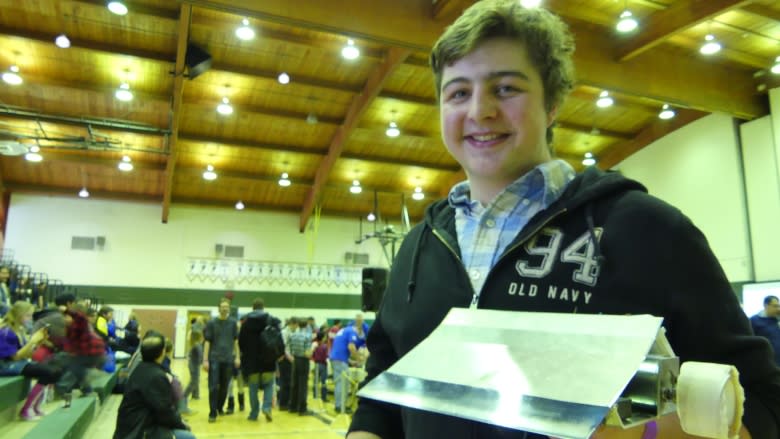Students' best bots battle it out at Manitoba Robot Games
More than 180 robots built by students from more than a dozen Manitoba schools duked it out on Saturday, battling over rough terrain and in sumo wrestling rings for the title of best bot.
"We don't actually make them smarter. What we do is we help reveal to students how smart they are and how capable they are, and how they can go on to greater and better things in this area," said Herb Reynolds, chair of the planning committee for the 23rd annual Manitoba Robot Games.
The event, held in the Field House at Winnipeg's Tec Voc High School, was open to some of the province's youngest builders, ranging from kids who haven't yet started school to teens about to graduate. Some of them have been working on their inventions for months, Reynolds said.
"I love it," said Emily Thorlakson, 10. This year was her fifth at the competition, and her little black-and-white robot, Baby, fought it out in the mini sumo wrestling category.
She built it from a kit at home in about six hours, she said, and it made her feel "incredible."
"I just love being able to build a robot and fight with it," she said.
Julian Kleinsasser, 17, has been competing in the event since he was in Grade 4, he said. Now in Grade 11 at Crystal Springs School in Ste. Agathe, Man., he brought three robots he built named Donkey, Try Harder and Faultier — the last "sloth" in German, named after the sloth from the Ice Age movies.
"It's fun. I like building stuff like that. It's a great environment. The races are fun, the people are awesome," he said.
He said building a robot is "pretty simple," as long as you've got the right materials and have a plan.
"You just build it, test it. Something breaks, you just do it again."
'1st rule of robots is: robots break'
In addition to robot sumo wrestling, where robots try to push each other out of a ring, machines could also compete in the "super scramble" — a rough-terrain race — and a tractor pull, among other events. The operators of the top three bots get a plaque, a cash prize, a T-shirt and a trophy they keep for the year.
Reynolds said between 180 and 200 robots were registered, with more than 200 student creators behind them.
He said the most important part of the event to him is what students take away from it.
"What students get is some experience doing something and making something work," he said. "They do wiring, they do mechanical work, they design and most of all, they solve problems, because the first rule of robots is: robots break."
This year's Manitoba Robot Games started at 10 a.m. and ran until 5 p.m. on Saturday. Participants paid $5 per robot and admission was free.



